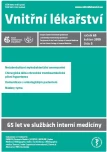Limited ambulatory night sleep testing in patients with a suspicion of sleep apnoea syndrome: Is its indication tenable?
Authors:
Milan Sova 1; Samuel Genzor 1; Petra Palyzová 2; Jana Zapletalová 3; Amjad Ghazal Asswad 2; Vítězslav Kolek 1
Authors place of work:
Klinika plicních nemocí a tuberkulózy LF UP a FN Olomouc
1; LF UP v Olomouci
2; Ústav lékařské biofyziky LF UP v Olomouci
3
Published in the journal:
Vnitř Lék 2019; 65(5): 348-351
Category:
Původní práce
Summary
Introduction:
Ambulatory sleep testing is nowadays an available diagnostic method, measuring air flow and blood oxygen saturation in patients with a suspicion of obstructive sleep apnoea syndrome (OSAS). It can be performed by either a general practitioner or an ambulatory specialist in various fields. Using this simple screening method it is possible to exclude subjects without OSAS, who therefore do not require further sleep testing at a sleep laboratory. There is no published data regarding the use of ambulatory sleep testing by sleep laboratories in the Czech Republic.
The aim of this study was to evaluate the proportion of patients examined by ambulatory sleep testing and to determine the factors influencing its indication.
Material and methods:
The study involved 497 patients (363 males) with an average age of 55.5 ± 12.3 years. These patients were tested by the sleep laboratory at University Hospital Olomouc with a suspicion of OSAS. The clinical complaints of the patients were evaluated (e.g. excessive daytime sleepiness, microsleeps, etc.) along with a basic examination, including anthropometric parameter measurements, on admission to the ward. Whilst admitted, night sleep testing using respiratory polygraphy or videopolysomnography was performed in all patients. Furthermore, the number of patients that underwent ambulatory sleep testing prior to admission to the sleep laboratory and the number of patients with an indication for positive airway pressure therapy (PAP) (apnoea-hypopnea index > 15) was assessed. The results were processed using the software IBM SPSS Statistics v22.
Results:
Ambulatory sleep testing was performed in only 96 patients (19.3 %). Among these patients, 76 (79.0 %) were diagnosed with OSAS with an indication for PAP. In the 401 patients who did not undergo ambulatory sleep tests, 227 (53.9 %) were diagnosed with OSAS with an indication for PAP. Patients who underwent ambulatory sleep tests and those who did not differed only in age (p = 0.03). There were no significant differences in other parameters (sex, height, weight, BMI, circumference of neck, waist and hips, ESS), including sleepiness (p = 0.605) and microsleeps (p = 0.74).
Conclusion:
Ambulatory sleep testing is performed in only a small proportion of patients. Its use can reduce healthcare costs as well as waiting times for sleep laboratory tests.
Keywords:
ambulatory night sleep testing – sleep apnoea
Zdroje
- American Academy of Sleep Medicine: International classification of sleep disorders (ICD-3). 3rd diagnostic and coding manual. American Academy of Sleep Medicine: Westchester 2014.
- Hajduk IA, Strollo PJ, Jasani RR et al. Prevalence and predicition of nocturia in obstructive sleep apnea-hypopnea syndrome – a retrospective study. Sleep 2003; 26(1): 61–64.
- Kryger M, Roth T, Dement W et al. Principles and Practice of Sleep Medicine. 6th ed. Elsevier 2017. ISBN 9780323242882.
- Ulasli SS, Gunay E, Koyuncu T et al. Predictive value of Berlin Questionnaire and Epworth Sleepiness Scale for obstructive sleep apnea in a sleep clinic population. Clin Respir J 2014; 8(3): 292–296. Dostupné z DOI: <http://dx.doi.org/10.1111/crj.12070>.
- Chung F, Subramanyam R, Liao P et al. High STOP-Bang score indicates a high probability of obstructive sleep apnoea. Br J Anaesth 2012; 108(5): 768–775. Dostupné z DOI: <http://dx.doi.org/10.1093/bja/aes022>.
- Erman MK, Stewart D, Einhorn D. Validation of the ApneaLink for the screening of sleep apnea: a novel and simple single-channel recording device. J Clin Sleep Med 2007; 3(4): 387–392.
- Sommermeyer D, Zou D, Grote L et al. Detection of sleep disordered breathing and its central/obstructive character using nasal cannula and finger pulse oximeter. J Clin Sleep Med 2012; 8(5): 527–533. Dostupné z DOI: <http://dx.doi.org/10.5664/jcsm.2148>.
- Hirscher V, Unbehaun T, Feige B et al. Patients with primary insomnia in the sleep laboratory: do they present with typical nights of sleep? J Sleep Res 2015; 24(4): 383–389. Dostupné z DOI: <http://dx.doi.org/10.1111/jsr.12280>.
- Pretl M, Hobzova M, Honnerova M et al. Indikační kritéria pro léčbu poruch dýchání ve spánku pomocí přetlaku v dýchacích cestách u dospšlých. Dokument České společnosti pro výzkum spánku a spánkovou medicínu. Neurologie pro praxi 2013; 14(1): 38–41. Dostupné z WWW: <http://www.pneumologie.cz/upload/1480186001.pdf>.
- Bibbins-Domingo K, Grossman DC, Curry SJ. [US Preventive Services Task Force]. Screening for Obstructive Sleep Apnea in Adults: US Preventive Services Task Force Recommendation Statement. JAMA 2017; 317(4): 407–414. Dostupné z DOI: <http://dx.doi.org/10.1001/jama.2016.20325>.
- Calhoun DA, Harding SM. Sleep and hypertension. Chest 2010; 138(2): 434–443. Dostupné z DOI: <http://dx.doi.org/10.1378/chest.09–2954>.
- Lee CH, Khoo SM, Tai BC et al. Obstructive sleep apnea in patients admitted for acute myocardial infarction. Prevalence, predictors, and effect on microvascular perfusion. Chest 2009; 135(6): 1488–1495. Dostupné z DOI: <http://dx.doi.org/10.1378/chest.08–2336>.
- Sahlin C, Snadberg O, Gustafson Y et al. Obstructive sleep apnea is a risk factor for death in patients with stroke. Arch Intern Med 2008; 168(3): 297–301. Dostupné z DOI: <http://dx.doi.org/10.1001/archinternmed.2007.70>.
- Perraudin C, Le Vaillant M, Pelletier-Fleury N. Cost-Effectiveness of a Community Pharmacist-Led Sleep Apnea Screening Program – A Markov Model. PLoS One 2013; 8(6): e63894. Dostupné z DOI: <http://dx.doi.org/10.1371/journal.pone.0063894>.
- Rajagopalan N. Obstructive sleep apnea: not just a sleep disorder. J Postgrad Med 2011; 57(2): 168–175. Dostupné z DOI: <http://dx.doi.org/10.4103/0022–3859.81866>.
Štítky
Diabetologie Endokrinologie Interní lékařstvíČlánek vyšel v časopise
Vnitřní lékařství

2019 Číslo 5
- MINISERIÁL: Když ženám stoupá tlak...
- Tirzepatid – nová éra v léčbě nadváhy a obezity
- Není statin jako statin aneb praktický přehled rozdílů jednotlivých molekul
- Specifika v komunikaci s pacienty s ránou – laická doporučení
Nejčtenější v tomto čísle
- Netuberkulózní mykobakteriální onemocnění – editorial
- Komunikace s onkologickým pacientem
- Chirurgická léčba chronické tromboembolické plicní hypertenze
- Limitovaná ambulantní noční monitorace spánku u pacientů s podezřením na syndrom obstrukční spánkové apnoe: Je dostatečně indikovaná?
